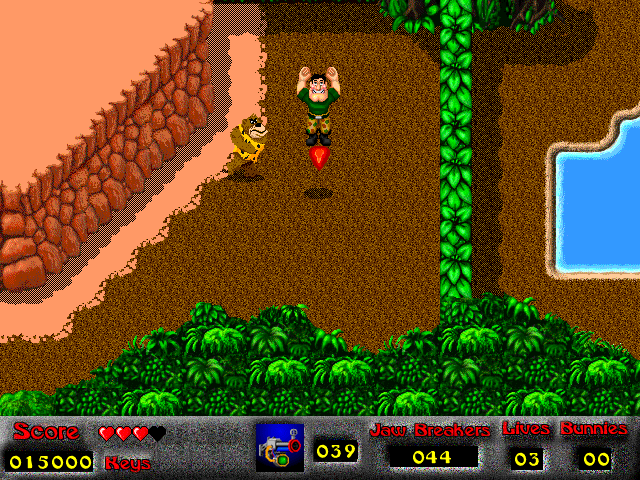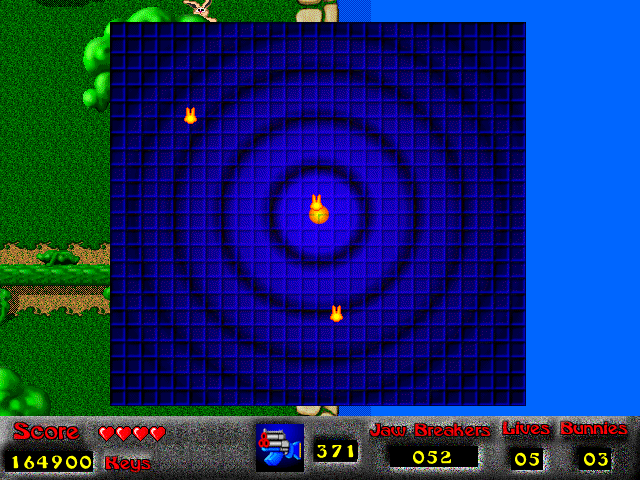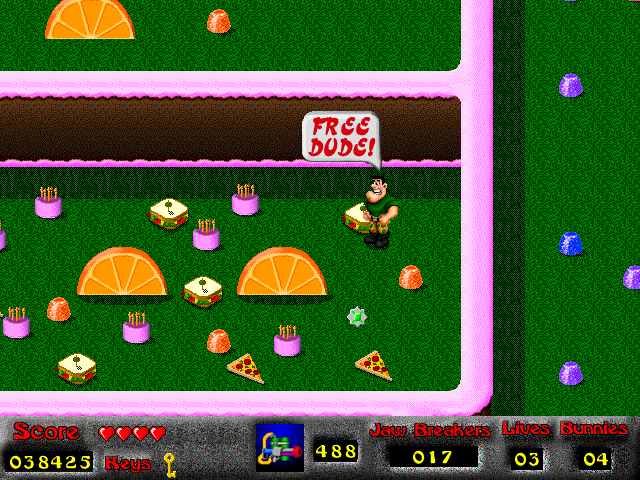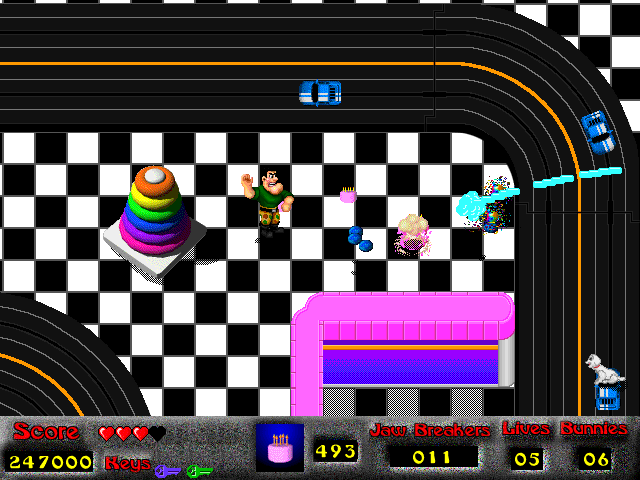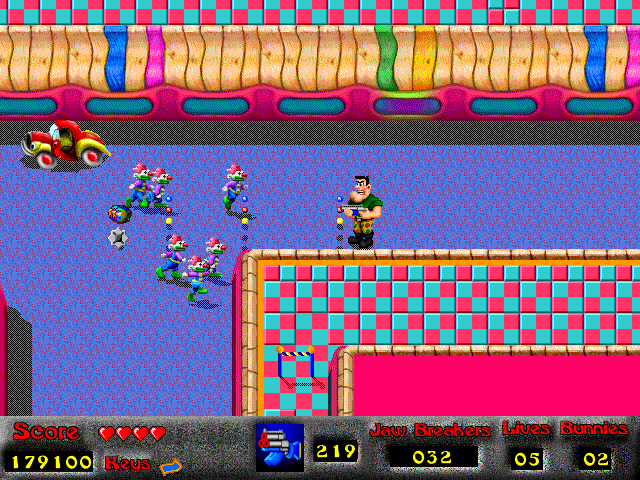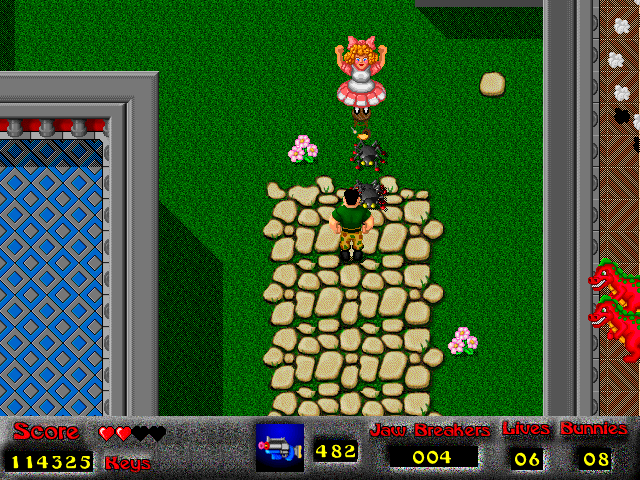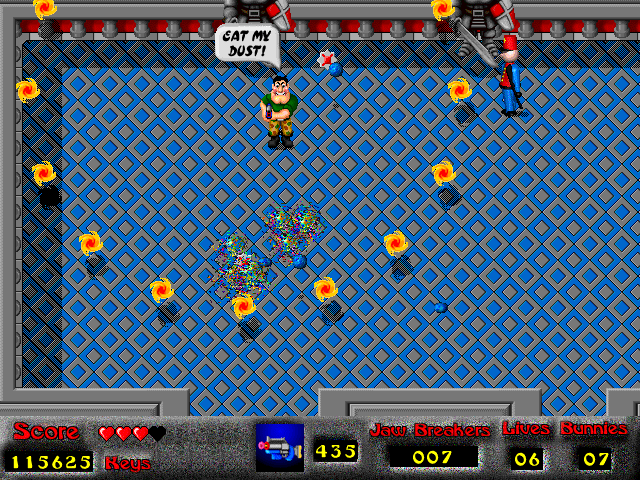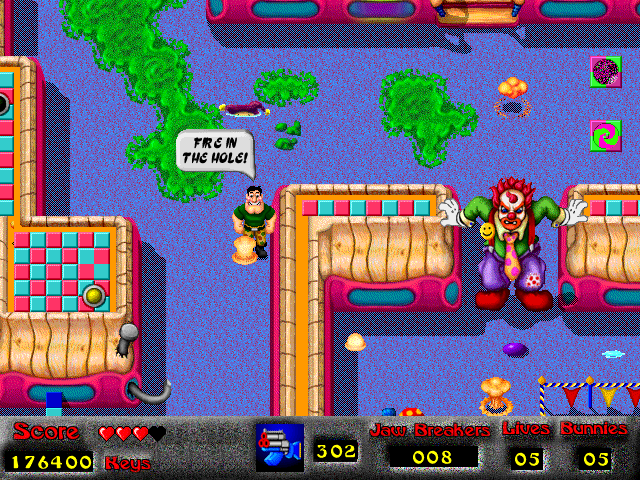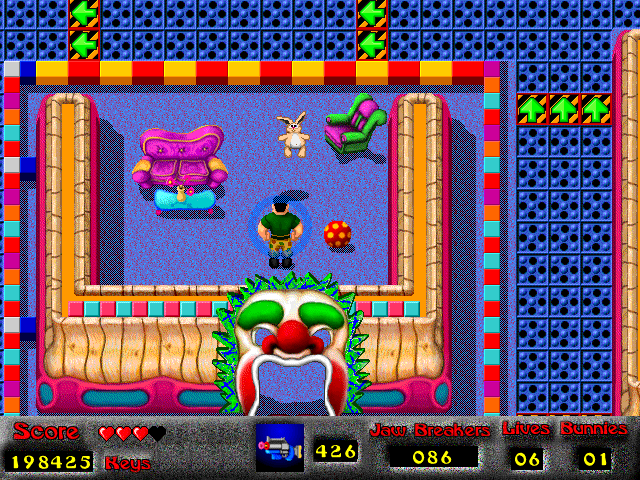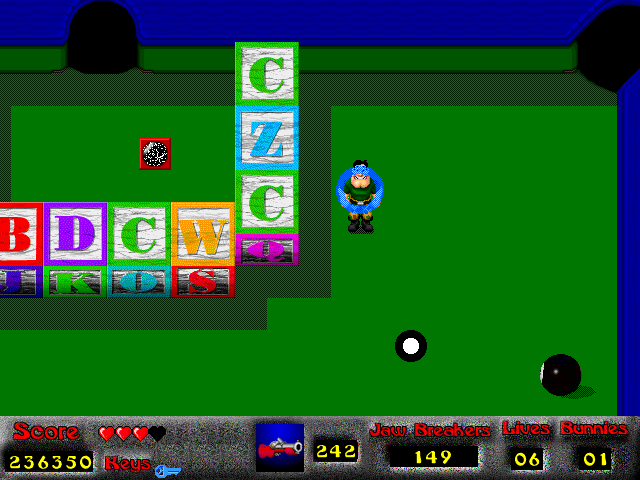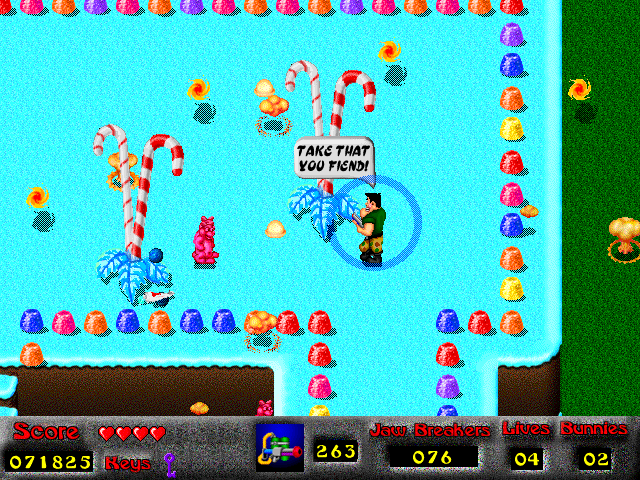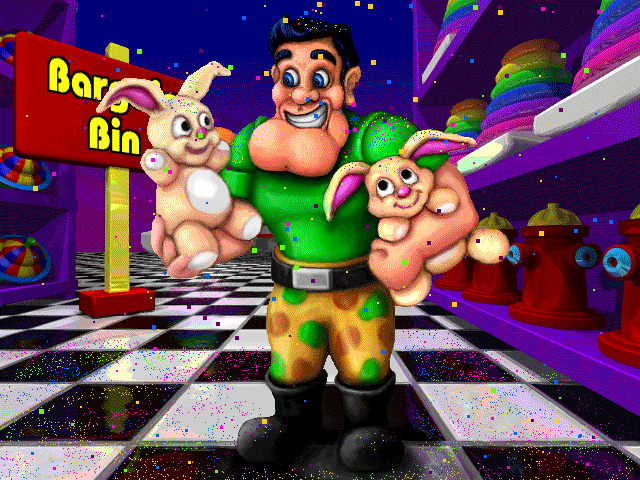Mighty Mike/Power Pete – Pangea Software - 1995 - First time playing?: Yes!
Once open hours are over and the toy shop is closed for the night, the aisles and departments transform into jungles, candy lands, castles and circuses, as all of the toys spring to life. When all of the Fuzzy Bunnies escape from their enclosure in the zoo, it's up to the popular action figure Mighty Mike (also known as Power Pete in the earlier versions) to rescue them all from the evil toys before they get themselves hurt.
Mighty Mike (also known as Power Pete for its initial retail release) was one of Pangea Software's earliest big hits on Mac OS. Pangea is a particularly notable developer in the Mac gaming scene and it's very likely that if you grew up playing Mac games, your introduction to them would have been one of Pangea's titles. They were commonly bundled with Mac computers and often served as impressive tech demos of what the hardware can do. I love Pangea, primarily because of nostalgia I will admit, but also because they're completely nuts. Pangea games are… odd. Their characters are odd, their settings and stories are odd, their gameplay is odd, their level design is odd, there's just this surreal strangeness and feeling of something being off to so much of their library, and honestly I'm not sure how much I'm laughing at them versus laughing with them. Either way I find them to be hilarious good fun. They may not always have the best game design in the world, but they're polished on a technical level and filled with bizarre charm.
However, unlike Nanosaur or Bugdom, I never played Mighty Mike as a kid, so I can go into this one without that nostalgic bias and see how one of their classic games holds up without the rose tinted glasses. Happy to say, I quite enjoyed Mighty Mike. It's for the most part a very polished and enjoyable explorative run & gun akin to Zombies Ate My Neighbors with a large variety of weapons to use and enemies to blast. There's still some design quirks that hold it back from greatness in my opinion, but it's still a respectable very good game at the very least.
One of those quirks needs to be addressed as early as the main menu. Before you start playing, do yourself a favour and go to the difficulty menu and change the difficulty setting to hard. The default difficulty of medium locks you out of the final three levels, making the game unbeatable and ending prematurely. Locking out content on lower difficulties was a common practice in games at the time, but that was usually reserved for easy mode instead, with the default difficulty setting still being high enough to see the full game. No such luck here, afraid, and it's far less likely that you'll have the confidence to set the difficulty to hard on your first playthrough too. At the very least the game is still pretty easy for the most part even on the highest difficulty, to the extent that I beat it twice quite comfortably with no game overs without even knowing that you could upgrade your max HP.
Mechanically it’s a very simple game. Mike can move and shoot and that’s about it for controls. You always fire in the direction Mike is currently facing, so it’s not a twin stick shooter where you can aim independently of your movement, bringing it closer to the likes of Alien Syndrome and Zombies Ate My Neighbors. Other than shooting the only other buttons are one that cycles through your weapons and another that brings up a radar showing you in what direction you can find all of the bunnies. The game is essentially a collect-a-thon as a level is beaten once you collect all of the bunnies, adding a non-linear level structure where you’re often given a level of freedom in deciding what order to get the bunnies in.
With such simple mechanics, it’s the level design and weapon arsenal that keeps Mighty Mike engaging for its 15 levels. The levels are large and sprawling with some light puzzles mixed in and various keys and locked doors to unlock. Secrets are plentiful too, with large deposits of ammo and extra lives present in many of the levels that can be found by going off the beaten path, walking through fake walls or walking around the edge of the level. Many powerful weapons can be found early if you do this making it well worth your while.
As for the weapons, there’s a ton of them, at least 13 of them assuming that I didn’t miss any. You start out with a simple suction cup dart gun but you’ll quickly get loaded up with gumball blasters, a flamethrower, a musket, custard pies, rubber band shooters and more. The flame thrower is really satisfying and excellent for fast hard-hitting close-range damage, yet the most powerful of this massive arsenal? Birthday cakes. You lob them like a grenade and they deal splash damage once they splatter on the floor, dealing high damage and one-shotting nearly every enemy with decent coverage. Certain weapons are more effective against certain enemies, while some enemies are completely immune to a few weapons, indicated by a “tink” sound letting you know you’re not doing damage. Irritatingly, there’s no visual indication of if your attacks are doing damage or not. Enemies don’t blink or flinch or anything when they take damage which can leave you wondering if your attacks even landed even when you’re not hearing the tink sound.
The weapons are pretty fun but there may be a little too many. I’m absolutely not opposed to the variety, but a lot of the weapons end up outclassed by other weapons that are just “that other one but better”. For instance, the double barrelled gumball blaster may be cool, but once you have the triple barrelled gumball blaster it’s very much outclassed. The same can be said for the musket being a superior version of the starting dart gun. What doesn’t help is that selecting weapons can be clumsy too. There’s only a single button for selecting weapons that cycles through them one-by-one as you tap the button.This means if in a panic in the middle of a firefight you accidentally skip over the weapon you want, you can’t go back since there’s no button for cycling weapons backwards, so you have to press the button 12 more times to get back around to the weapon you want. Having weapons mapped to the number keys to quickly select like in Doom would help a ton, in addition to perhaps being able to tap the same key more than once to switch to a different version of the same weapon like the gumball blasters, the same way the 3 key in Doom II is mapped to both the shotgun and the super shotgun.
The game takes place over five worlds with three levels each. Starting in Prehistoric Plaza, you’ll then move onto Candy Cane Lane, Fairy Tale Trail, Magic Funhouse and finally the Bargain Bin. The overreliance on the “Unga Bunga” cavemen enemies at the start of Prehistoric Plaza might trick you into thinking this game lacks enemy variety, but there’s actually a really impressively diverse range of toys to fight with each world having roughly five to seven unique different enemy types. Fairy Tale Trail has the most stand-out enemies in my mind, from the witches who transform you into a frog and Little Miss Muffet who lets out a scream as an infinite supply of spiders spawn out from under her dress. Um, maybe I could have worded that better. Little Miss Muffet rapidly gives birth to- nope okay I can’t make this sound any less dirty, moving on.
Enemies drop jawbreakers on defeat alongside powerups and weapon ammo. The jawbreakers can be collected to earn extra points upon completing the level, and in addition if you collect enough of them in a single level then at the end of level score tally your health bar will be extended by one heart. How many jawbreakers does it take? I have no idea and the manual has no idea either. The manual claims it takes a ridiculous 500 jawbreakers, but I managed to get the extra hitpoint by just collecting 200. In terms of powerups, these range from special attacks such as filling the screen with explosions or a shockwave, as well as a shield that makes you invincible for a short period of time or a speed-up which makes you near uncontrollably fast. These are rarely game changers but absolutely still come in handy, especially the power-up that freezes enemies in their place which can make large overwhelming hordes a breeze.
In addition to enemies, each stage also has its own hazards. These can be floor tiles that either damage you, slow you down or have ice physics, or they may be annoying traps like the poison apples in Fairy Tale Trail which are completely indistinguishable from the regular apples that heal you. The worst though, absolutely it has to be the funhouse, just the entire bloody Magic Funhouse…
So, for the first three worlds the game’s level design is pretty good, with nice and open explorative levels, occasionally a little cryptic but manageable with the bunny radar. The first Magic Funhouse level is also mostly fine, a little too much acidic clown vomit for my tastes but still fine (the manual claims it’s actually rotten cream but I know clown vomit when I see it). Then the second level of the Magic Funhouse hits with one of the most ridiculously tedious trial and error levels I’ve ever played. The entire level is a massive maze with one-way tiles and almost entirely covered in air hockey tiles. These tiles blow gusts of air that push you in a direction. What direction do they push you? Impossible to tell. How strong is that push? Also impossible to tell. Every single air hockey tile uses the exact same sprite regardless of the strength of the air gust or what direction it will push you in. While fighting the air gusts you’re also having to navigate an already confusing maze where one slip-up will send you all the way back to the start of the level, which is extremely likely to happen since the gusts of wind are constantly trying to push you into one-way corridors that force you back to the start. There’s no way to tell what specific obtuse route the game wants you to take to get to the bunnies. This level took me about 30 minutes on my first playthrough, it was agony. It’s not challenging, it doesn’t have too many enemies and it’s filled to the brim with healing items making it pretty forgiving, but I had to spend so much time going around in circles getting jerked all over the place out of my control until I finally figured it out. On my second playthrough however, even though I didn’t remember the layout as it was a month later, I still ended up finding it a lot easier, doing it in under 10 minutes this time. If you know what to expect and have a general idea of how it messes with you, it’s not nearly as bad, but it’s painful on a first playthrough.
That’s the worst of it however, once you’re through that one rough level the rest of the game following it is fine. Bargain Bin can be a little annoying in places with the pool tables where each hole on the table sends you on a one-way warp to somewhere else in the level that you can only figure out via once again, trial and error, but it’s on a much smaller scale than the massive sprawling air hockey maze and the levels overall are fun, with UFOs you get to fly around the levels which give you super speed and tank hits for you. There’s no final boss at the end of the game, or any bosses period for that matter, which is a little disappointing but not a deal breaker.
In terms of presentation, the sprite work is nice and colourful and cartoony and while the sprite animation can be a bit rigid it still looks good definitely. Pangea Software after Mighty Mike exclusively made fully 3D polygonal games so it’s cool seeing their take on sprite-based graphics. The game adds extra bits of personality via occasional one-liners from Mighty Mike spoken in a pitch-shifted squeaky voice, as well as enemies often tauntingly cackling at you. The amount of quotes are a little limited however, so get used to hearing “eat my dust!” and “take that you fiend!” ad-nauseam. The music is a little weak however, by no means bad but the loops are just a little short and too repetitive for the massive lengthy levels and not nearly as memorable as Pangea’s later soundtracks.
Some rare occasions of tedious level design aside, Mighty Mike is a good time and in spite of its simplicity it manages to get a lot of mileage out of those simple mechanics with variety in enemies, weapons and level design. I absolutely recommend checking out the recent open source port to Windows, Linux and modern Mac OS by Jorio. Jorio has done an absolutely superb job at porting over many of Pangea’s games to modern platforms, entirely for free with Pangea’s blessing. Mighty Mike’s port especially went above and beyond, not only uncapping the framerate and making the game wide-screen and redesigning the HUD to suit that aspect ratio, but also adding the ability to play with twin-stick controls if you desire. It’s easily the definitive version of the game now and was actually the first version of the game I played, only more recently playing the Mac original for this review. The Mac version is also solid however. I thought that the lack of twin stick shooting might make things harder but it wasn’t actually much of a setback at all as the game is clearly designed around that restriction. Jorio's Mighty Mike port can be found here!
- Page written by MSX_POCKY, 25th March 2023

